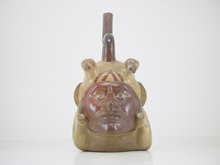
Erotic art is a broad field of the visual arts that includes any artistic work intended to evoke erotic arousal. It usually depicts human nudity or sexual activity, and has included works in various visual mediums, including drawings, engravings, films, paintings, photographs, and sculptures. Some of the earliest known works of art include erotic themes, which have recurred with varying prominence in different societies throughout history. However, it has also been widely considered taboo, with either social norms or laws restricting its creation, distribution, and possession. This is particularly the case when it is deemed pornographic, immoral, or obscene.
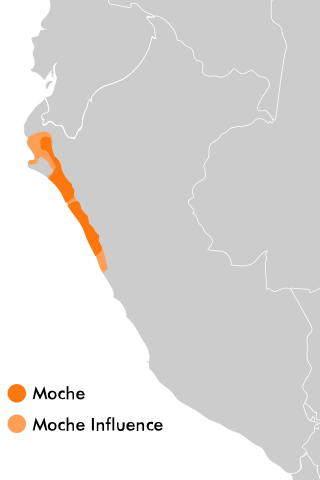
The Moche civilization flourished in northern Peru with its capital near present-day Moche, Trujillo, Peru from about 100 to 700 AD during the Regional Development Epoch. While this issue is the subject of some debate, many scholars contend that the Moche were not politically organized as a monolithic empire or state. Rather, they were likely a group of autonomous polities that shared a common culture, as seen in the rich iconography and monumental architecture that survives today.

Ceramics of Indigenous peoples of the Americas is an art form with at least a 7500-year history in the Americas. Pottery is fired ceramics with clay as a component. Ceramics are used for utilitarian cooking vessels, serving and storage vessels, pipes, funerary urns, censers, musical instruments, ceremonial items, masks, toys, sculptures, and a myriad of other art forms.

Huaco or Guaco is the generic name given in Peru mostly to earthen vessels and other finely made pottery artworks by the indigenous peoples of the Americas found in pre-Columbian sites such as burial locations, sanctuaries, temples and other ancient ruins. Huacos are not mere earthenware but notable pottery specimens linked to ceremonial, religious, artistic or aesthetic uses in central Andean, pre-Columbian civilizations.
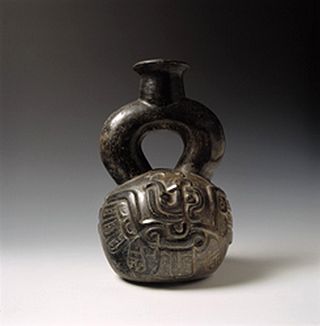
The Cupisnique culture was a pre-Columbian indigenous culture that flourished from c. 1500 to 500 BC along what now is Peru's northern Pacific coast. The culture had a distinctive style of adobe clay architecture. Artifacts of the culture share artistic styles and religious symbols with the Chavin culture that arose in the same area at a later date.

Huaca Rajada, also known as Sipán, is a Moche archaeological site in northern Peru in the Lambayeque Valley, that is famous for the tomb of Lord of Sipán, excavated by Walter Alva and his wife Susana Meneses beginning in 1987. The city of Sipán is dated from 50–700 AD, the same time as the Moche Period.
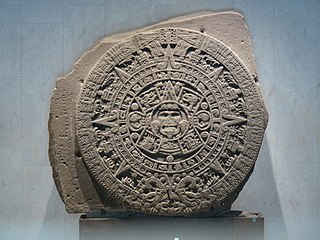
Pre-Columbian art refers to the visual arts of indigenous peoples of the Caribbean, North, Central, and South Americas from at least 13,000 BCE to the European conquests starting in the late 15th and early 16th centuries. The Pre-Columbian era continued for a time after these in many places, or had a transitional phase afterwards. Many types of perishable artifacts that were once very common, such as woven textiles, typically have not been preserved, but Precolumbian monumental sculpture, metalwork in gold, pottery, and painting on ceramics, walls, and rocks have survived more frequently.
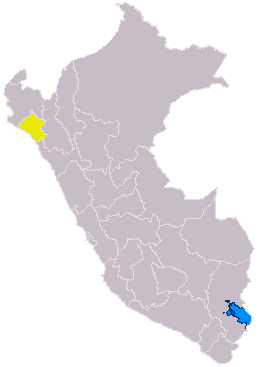
The Sican culture is the name that archaeologist Izumi Shimada gave to the culture that inhabited what is now the north coast of Peru between about 750 and 1375 CE. According to Shimada, Sican means "temple of the Moon". The Sican culture is also referred to as Lambayeque culture, after the name of the region in Peru. It succeeded the Moche culture. There is still controversy among archeologists and anthropologists over whether the two are separate cultures. The Sican culture is divided into three major periods based on cultural changes as evidenced in archeological artifacts.

The Larco Museum is a privately owned museum of pre-Columbian art, located in the Pueblo Libre District of Lima, Peru. The museum is housed in an 18th-century vice-royal building. It showcases chronological galleries that provide a thorough overview of 5,000 years of Peruvian pre-Columbian history. It is well known for its gallery of pre-Columbian erotic pottery.

Rafael Larco Hoyle, raised at Chiclin, his family's estate, was sent to school in Maryland, United States, at the age of twelve. He later entered Cornell University to study agricultural engineering and by 1923 returned to Peru to work on the family's sugar cane plantation. After spending most of his youth abroad, Larco Hoyle arrived to Peru with the eyes of an outsider. With this foreigner's curiosity he explored the country and discovered an ancient cultural patrimony in the north coast. Larco Hoyle recognized the need to house these objects in a safe place. It was at that point, Larco Hoyle dreamt of a museum, one like he had seen in the United States.

Some evidence for homosexual behavior in pre-Columbian Peru has survived since the Spanish conquest of Peru in the form of erotic ceramics. Such pottery originated from several ancient civilizations of Peru, the most famous of these being the Moche and Chimu cultures.

Painting in the Americas before European colonization is the Precolumbian painting traditions of the Americas. Painting was a relatively widespread, popular and diverse means of communication and expression for both religious and utilitarian purpose throughout the regions of the Western Hemisphere. During the period before and after European exploration and settlement of the Americas; including North America, Central America, South America and the islands of the Caribbean, the Bahamas, the West Indies, the Antilles, the Lesser Antilles and other island groups, indigenous native cultures produced a wide variety of visual arts, including painting on textiles, hides, rock and cave surfaces, bodies especially faces, ceramics, architectural features including interior murals, wood panels, and other available surfaces. Many of the perishable surfaces, such as woven textiles, typically have not been preserved, but Precolumbian painting on ceramics, walls, and rocks have survived more frequently.

A stirrup spout vessel is a type of ceramic vessel common among several Pre-Columbian cultures of South America beginning in the early 2nd millennium BCE.
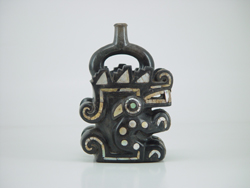
The Moche Crawling Feline is a specific stirrup spout vessel dating from 100—800 CE. This Moche ceramic effigy is currently in the collection of Larco Museum, in Lima, Peru. It comes from the North Coast of Peru. It represents a zoomorphic character: a lunar dog, or a crawling feline.

Mississippian culture pottery is the ceramic tradition of the Mississippian culture found as artifacts in archaeological sites in the American Midwest and Southeast. It is often characterized by the adoption and use of riverine shell-tempering agents in the clay paste. Shell tempering is one of the hallmarks of Mississippian cultural practices. Analysis of local differences in materials, techniques, forms, and designs is a primary means for archaeologists to learn about the lifeways, religious practices, trade, and interaction among Mississippian peoples. The value of this pottery on the illegal antiquities market has led to extensive looting of sites.
San Jose de Moro is a Moche archaeological site in the Pacanga District, Chepén Province, La Libertad Region, of Northwestern Peru. The site served as a ceremonial funerary complex between the years 400 and 1000 AD.

Pacopampa is an archaeological site located in the northern highlands of Peru, in the department of Cajamarca. It presents the remains of a monumental ceremonial center, made with cut and polished stone. It belongs to the Formative period, dating from 1200 to 500 BC. The land where the reservoir extends belongs to the National University of San Marcos, which through its Rural Andean History Seminar cares permanently for the monument.

The Recuay culture was a pre-Columbian culture of highland Peru that flourished from 200 BCE to 600 CE and was related to the Moche culture of the north coast. It is named after the Recuay District, in the Recuay Province, in the Ancash Region of Peru.

Ceramic art is art made from ceramic materials, including clay. It may take varied forms, including artistic pottery, including tableware, tiles, figurines and other sculpture. As one of the plastic arts, ceramic art is a visual art. While some ceramics are considered fine art, such as pottery or sculpture, most are considered to be decorative, industrial or applied art objects. Ceramic art can be created by one person or by a group, in a pottery or a ceramic factory with a group designing and manufacturing the artware.

Teófilo Rafael Andrés Wenceslao Larco Herrera was a Peruvian politician, businessman, and philanthropist. He was first vice-president of Peru during the first Government of Manuel Prado (1939–1945), as well as minister of Foreign Relations and interim minister of Finance and Commerce, on the cabinet led by David Samanez Ocampo (1931).



